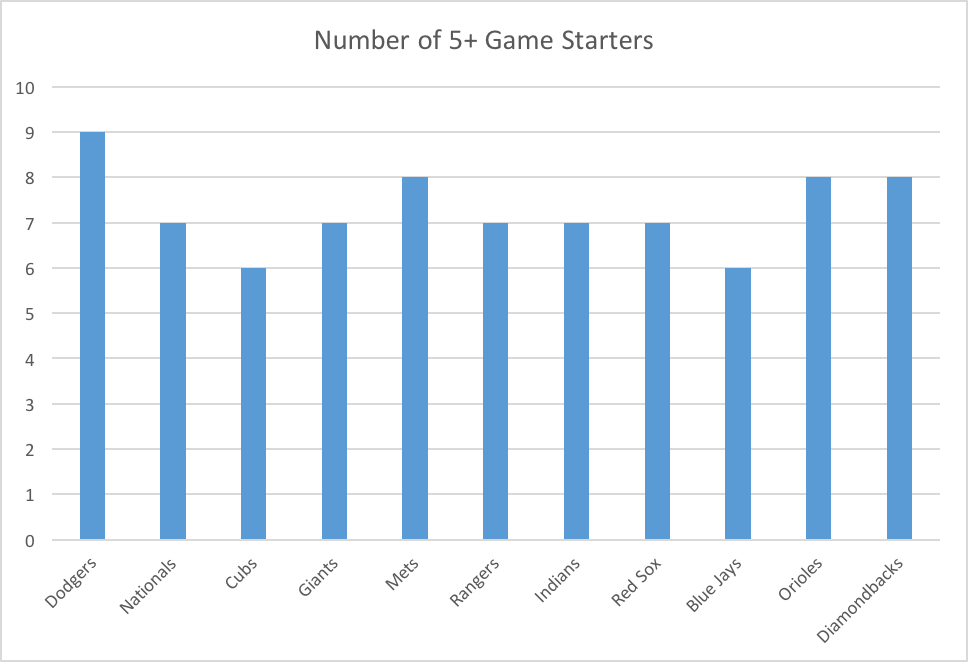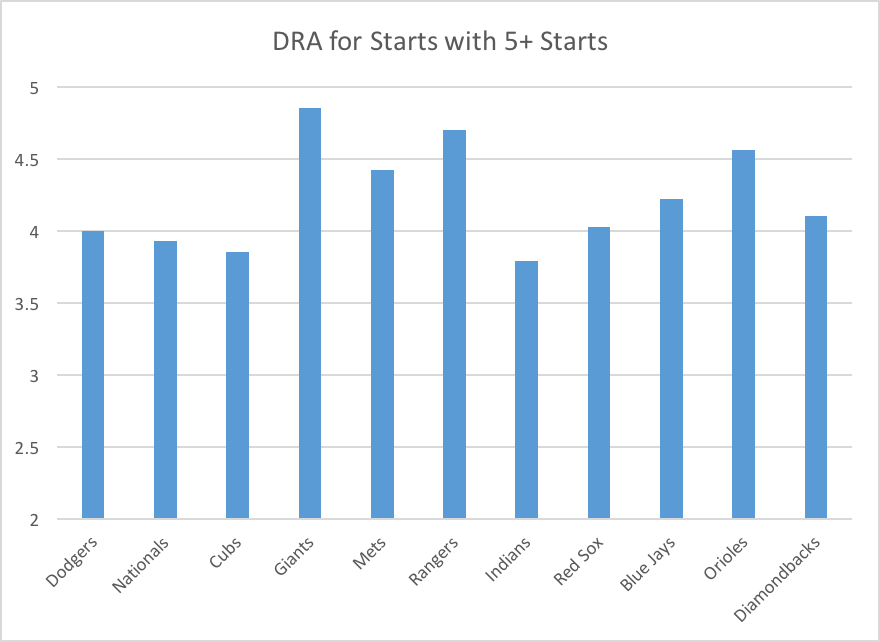The D-backs Rotation, Playoff Rotations, and Depth
The playoffs started yesterday, and that’s both good and bad. Playoff baseball is fun (good), but with every passing final box score, we’re reminded that the long, cold, dead, baseball-less winter is fast approaching (bad). The Jays beat the Orioles in a game that’ll remain notorious for Buck Showalter neglecting to use Zach Britton, the best reliever in baseball, perhaps, instead opting to use a starter out of the ‘pen in extra innings. Edwin Encarnacion did what we’ve seen him do to the D-backs firsthand, and that is to say, he walked his parrot around the bases after a monster 11th-inning walk-off homer. That at least made for good entertainment.
But all of the talk about pitching entering the postseason made me wonder something. How does the current Diamondbacks rotation compare to the rotations of the teams in the playoffs? There’s an interesting trend that’s come along slowly over the last several years, and that’s the fact that teams are less likely than ever to be able to truly lean on a five-man rotation to get through the 162-game MLB schedule. More and more, teams are relying on depth to help nurse them through the season. That’s due in large part to the escalating nature of pitcher injuries, but also due to monitoring and limiting pitch counts in an attempt, perhaps in vain, to avoid those injuries altogether. The Dodgers, in fact, set a record for starters used in a season with 15 pitchers making at least one start. That’s a lot of pitchers, and while they’ve dealt with countless injuries, the moves made over the winter by the Dodgers’ front office to add a bulk of depth instead of paying for premium pitching have paid off by and large. It looks like this strategy of depth is a promising one and it’s worth applying to the Diamondbacks, at least in theory.
First, have a look at the number of starters for each playoff team, and the D-backs, who are quite clearly not a playoff team, with at least five starts made.
Not surprising, the Dodgers lead the way here with nine starters who started five or more games. The Cubs and Blue Jays are on the other end with just six used, as they were able to avoid injuries total implosions for the most part. The average for this group of playoff teams is 7.2 starters with five or more starts made. That might suggest that Arizona shouldn’t just focus on having five solid starters in Sedona Red in 2017, but rather closer to seven of them. So, let’s put some specific focus on the back end of things today, looking at this issue of depth and if the Diamondbacks are in a position of strength or weakness here. But first, let’s do one last check to see how the the all-important aspect of quality plays into the equation. Here’s how the playoff, and also Diamondback, starters with five or more starts faired by DRA and WARP.
By DRA, the Diamondbacks checked in slightly better than average, with a DRA of 4.11 while the playoff teams’ average was 4.23. That might shock you — it sure surprised me — but if we acknowledge the lack of the DH in the NL, we can make some mental adjustments. Further, DRA is as context-neutral as possible, which I’ve broken down in more depth in the past, but we know that context matters. Chase Field remains a hitter’s park and the team had lousy pitch-framers behind the plate, so we would expect the on-field results to again skew against the team. In terms of “pure quality,” however, the D-backs stack up better than you might think even as they’re currently constructed. WARP takes these DRA principles into account, so for all of the adjustments we make for DRA, we also have to factor them in for WARP, where Arizona got slightly less production (14.4 WARP) than the average playoff team (15 WARP). If we take all of these little qualifiers into account for things the team can’t control (like the ballpark) and the things it can but won’t (pitch framing), we can clearly see that the team would need to be much better than average in terms of DRA and WARP to survive their environment. Simply put, the team is at a disadvantage and everyone knows it. Therefore, average most likely isn’t good enough for the D-backs.
Looking ahead, the team will have Zack Greinke, Robbie Ray, Patrick Corbin and Archie Bradley in their rotation next year on Opening Day, barring any unforeseen complications. We’d do well to not expect Rubby De La Rosa to return to the rotation at this point. If we’re focusing on seven starters being in the fold, we’d need three more names. Shelby Miller‘s obviously at the top of that list for reasons beyond our control, with Zack Godley, Braden Shipley, Matt Koch and a presumably healthy Tyler Wagner joining the list of candidates.
We have varying track records and sample sizes for these guys, but looking at just 2016, here are some observable statistics.
This list looks pretty ‘meh,’ but it’s supposed to look pretty ‘meh’ by definition of these guys being fringe candidates for a big league rotation. Of the group, Godley was clearly best. Wagner and his extra-heavy sinker looked good early in the season before a shoulder injury. Miller and Shipley were just not effective, but both can be better and we know that. Matt Koch should have been converted back to relief a long time ago and despite a start where he was truly locked on, his best role is probably in middle relief going forward. Edwin Escobar may still be around, but he didn’t provide anything special while Anthony Banda is a safe bet to begin the 2017 season in AAA.
While the top four starters in the D-backs’ rotation are full of questions, the back end doesn’t offer any more answers. The team will need seven guys they can count on, and while Zack Godley may appear the best option for the fifth spot technically, he’s unlikely to grab it with Shelby Miller still around. Braden Shipley can improve, but we won’t know until next spring if he’s capable of taking a big leap forward. The other back end candidates are far from reassuring. It should be said that these players have options and can be shuttled back and forth from AAA to the majors when needed, an important part of roster management. But in terms of quality, there’s something to be desired.
So while most of the offseason attention will focus on the front and middle of the rotation, the bullpen, corner outfielders, and, perhaps, even shortstop, the Diamondbacks could look to add some low-cost value by adding more quality depth to their cache or available starters. They won’t be buying another $30 million dollar player this winter, but they can find sneaky production by utilizing Zack Godley regularly and adding another similar arm or two to the mix, protecting the team in the likely event that they need to reach deep into the ranks to fill holes if/when injuries and inconsistencies strike. While Ryan laid out some guiding principles for the next Diamondbacks front office on Monday, I’ll submit this as another area where upside can be obtained to maximize production.
3 Responses to The D-backs Rotation, Playoff Rotations, and Depth
Leave a Reply Cancel reply
Recent Posts
@ryanpmorrison
 Congrats to @OutfieldGrass24 on a beautiful life, wedding and wife. He deserves all of it (they both do). And I cou… https://t.co/JzJtQ7TgdJ, Jul 23
Congrats to @OutfieldGrass24 on a beautiful life, wedding and wife. He deserves all of it (they both do). And I cou… https://t.co/JzJtQ7TgdJ, Jul 23 Best part of Peralta’s 108 mph fliner over the fence, IMHO: that he got that much leverage despite scooping it out… https://t.co/ivBrl76adF, Apr 08
Best part of Peralta’s 108 mph fliner over the fence, IMHO: that he got that much leverage despite scooping it out… https://t.co/ivBrl76adF, Apr 08 RT @OutfieldGrass24: If you're bored of watching Patrick Corbin get dudes out, you can check out my latest for @TheAthleticAZ. https://t.co/k1DymgY7zO, Apr 04
RT @OutfieldGrass24: If you're bored of watching Patrick Corbin get dudes out, you can check out my latest for @TheAthleticAZ. https://t.co/k1DymgY7zO, Apr 04 Of course, they may have overtaken the league lead for outs on the bases just now, also...
But in 2017, Arizona ha… https://t.co/38MBrr2D4b, Apr 04
Of course, they may have overtaken the league lead for outs on the bases just now, also...
But in 2017, Arizona ha… https://t.co/38MBrr2D4b, Apr 04 Prior to the games today, there had only been 5 steals of 3rd this season (and no CS) in the National League. The… https://t.co/gVVL84vPQ5, Apr 04
Prior to the games today, there had only been 5 steals of 3rd this season (and no CS) in the National League. The… https://t.co/gVVL84vPQ5, Apr 04
Powered by: Web Designers@outfieldgrass24
 This company is in my hometown and you may have noticed their gear around a ballpark near you. The pandemic has bee… https://t.co/FeRVd3zjGl, 14 mins ago
This company is in my hometown and you may have noticed their gear around a ballpark near you. The pandemic has bee… https://t.co/FeRVd3zjGl, 14 mins ago Scherzer's revenge there was pretty epic, 48 mins ago
Scherzer's revenge there was pretty epic, 48 mins ago See this throw? This is how you know Fauci is on his shit when it comes to infectious disease. Dude spent his time… https://t.co/EZmigdkAKl, 1 hour ago
See this throw? This is how you know Fauci is on his shit when it comes to infectious disease. Dude spent his time… https://t.co/EZmigdkAKl, 1 hour ago RT @Jody_Jackson: Hazen spoke to the media on the passing of scout Johan Maya “we are all terribly sad”. Maya died of COVID-19 in the Dominican Republic., 1 hour ago
RT @Jody_Jackson: Hazen spoke to the media on the passing of scout Johan Maya “we are all terribly sad”. Maya died of COVID-19 in the Dominican Republic., 1 hour ago RT @cowhitchurch: We are chatting at @baseballpro pro in T E N minutes. Let's talk expanded playoffs, Dustin May's surprise start, an… https://t.co/PTaysaT13l, 2 hours ago
RT @cowhitchurch: We are chatting at @baseballpro pro in T E N minutes. Let's talk expanded playoffs, Dustin May's surprise start, an… https://t.co/PTaysaT13l, 2 hours ago
Powered by: Web Designers









You left out Chris Sale
[…] The D-backs Rotation, Playoff Rotations, and Depth […]
[…] running out at least one extremely poor-fielding outfielder every day. And, let’s not forget, the starting rotation is probably an arm short of actually being okay, so there’s that, too. Like we said, the team has […]